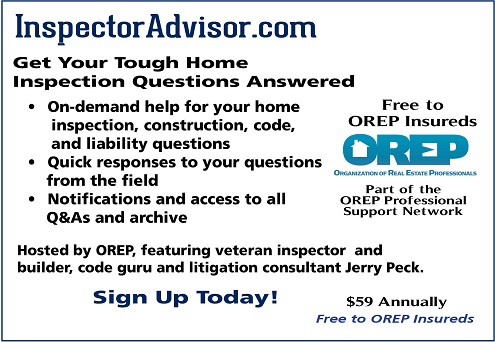 |
> What’s in Your E&O Policy? E&O/GL Insurance for Home Inspectors- *Broad Coverage *$1,000 minimum premium (premiums vary based on underwriting factors; choice of limits/deductibles) Shop OREP Now! |
Editor’s Note: This story appears in Working RE Home Inspector Edition (September 2017) OREP insureds receive guaranteed delivery.
Five Tips for Managing Client Complaints
By Joseph Denneler, Esquire
Home Inspectors face many challenges on a daily basis. While safety concerns and accuracy of findings are important components of your work, managing client expectations and dealing with occasional complaints are also part and parcel of being a professional home inspector. While nobody wants to deal with disgruntled clients, on the rare occasion you do get a complaint your response to it is critical.
There certainly is no absolute right or wrong way to respond to client complaints. Many professional home inspectors have had success using their good instincts and prior experience to work through them. While my list is by no means exhaustive, these five steps have been proven effective to limit your risk and protect your reputation.
One caveat before we begin: if you have E&O insurance, your first call should be to the carrier or agent to report the claim and to get it on the record to ensure your coverage will respond in case you need it.
1. Acknowledge the complaint. While an unhappy client is a problem, an unhappy and ignored client can cause a maelstrom. Giving the client no other recourse but to retain a lawyer or file a complaint with your licensing board or national association is never a safe bet.
It is important to also obtain a clear explanation from the client of the nature of their complaint so you can prepare for further investigation. The basis for the complaint may be something simple, related to your standards of practice or a condition you clearly identified in your report. Communicating with the client can give you an opportunity to immediately and decisively put a claim to rest.
Some of my clients prepare form reports for documenting client complaints or questions. Keeping an organized “diary” of the complaint process is important because it can help your attorney if the complaint becomes a lawsuit, and it can help you narrow the scope of your investigation to minimize the drain on your time. Even if you only receive a phone call from the client, acknowledge the complaint in writing in whatever fashion is appropriate. Complaints that become claims sometimes gestate for a year or more. Your recollection of events will never be clearer than immediately following that call. Documenting the complaint process will act as a timeline if needed later in the process.
2. Visit the property and inspect the conditions. You should always visit the property and personally observe the defects that form the basis of a claim. It gives you an opportunity to evaluate the conditions as they exist now versus when you inspected the property. Additionally, it gives you an opportunity to explain to your client why the condition was not discoverable during the inspection, or why it was outside the scope of your standards of practice.
Many claims arise after your client has done renovations or excavation of an area formerly obstructed by walls, floors and ceilings. Others arise after a severe weather event. The passage of time between your inspection and the notice of a claim can result in significant changes to the property. It is critical to identify potential defenses early in the claim process. Your insurance carrier or attorney needs to know early-on whether the alleged defect was hidden behind a wall now removed, or was in an area that was inaccessible for other reasons.
(story continues below)
(story continues)
Visiting the property also gives you an opportunity to snuff out a claim before it becomes a mental and financial drain on you and your business. Sometimes being able to explain to your client in person why a condition was not identified results in your client better understanding your scope of work and why a claim would be fruitless. If it’s a smaller issue, you have the opportunity to nullify the claim and move on (with a signed release of all claims, of course).
There may be occasions where, based on the tone of the communications about the claim, you do not believe it would be prudent to visit the property and engage the client. Investigating the claim is no different than doing the inspection where your safety is concerned. If you believe it unsafe, then it’s unsafe. A claim is not worth putting yourself in harm’s way.
3. Document the evidence. While visiting the site it is important that you document all of the conditions. This may be your only opportunity to record the conditions before repairs are made, or before the conditions worsen over time. In addition to fully photographing the conditions forming the basis of the claim, you should record any noticeable changes to the property since the date of your inspection.
Many of my cases involving home inspectors are not in litigation until a year or more after the inspection. By then repairs have been made, and the evidence I need to prove that a condition was hidden, or not visibly defective, is destroyed. Sometimes the condition gets worse in that time. I and any other lawyer representing an inspector in litigation, rely on you to preserve evidence of conditions at the time they were discovered when you are given the opportunity. Visual evidence is a powerful courtroom tool. Your photographs could form a meritorious defense. You should take any opportunity to preserve that evidence before a lawsuit is filed.
4. Avoid the flame war. The internet is the 20th century’s version of the printing press. It is an amazingly effective tool for marketing to and connecting with others. It is also a boneyard littered with the skeletons of communications gone awry.
(story continues below)
(story continues)
The advent of the digital age gave us consumer message boards, Facebook groups and many other avenues for sharing “ideas.” I’ve seen a spike in requests for assistance with addressing negative posts on Angie’s List, Yelp and other review sites. How you react to negative posts can greatly affect your defense if the complaint becomes litigation. You should assume that everything you post exists somewhere and can be retrieved. Everything. Responding in a less than professional manner to a client’s critique of your skills will undoubtedly be evidence used in an arbitration or trial. Tailor any responses so that you avoid arguing the merits of the claim.
5. Respond in a timely, professional manner. How you respond to a client’s complaint is important. All of your important communications with your client should be in writing. I’ve found that sending a dismissive response sometimes makes a difficult situation worse. I am certainly guilty of being blustery at times, but your written communication with a claimant must be a communication that can be read and understood by the claimant. This is not the time to make them pull out a dictionary or read a technical manual to find out what you mean.
I developed my methods for managing pre-litigation claims over years of trial and error. It is a part of my job as an attorney representing home inspectors. Responding to claims and complaints is hopefully not a routine part of your work. I’m happy to help you develop and manage your risk management plan. Much like you refer your clients to other professionals for specific problems, you should seek out experts in risk management and home inspector claims to help you with those specific problems. Let us know if we can assist.
Free Training
Home inspectors who purchase their insurance from OREP enjoy free training webinars from Mike Crow and his team at MIC, including The Home Inspector Marketing Success Formula and 10 Strategies to Get 10 More Referrals Per Month. How much would 10 more referrals add to your bottom line? Crow shows you proven strategies for getting more referrals and helps you master the latest home inspector marketing techniques.
Take advantage of this and many other business building benefits from the OREP Professional Support Network when you shop OREP. OREP insureds email isaac@orep.org to access these free training courses.
About the Author
Joseph W. Denneler, Esquire, is a trial attorney specializing in representing home inspectors in litigation. He developed his Claims Assist program to assist inspectors with managing risk. You can get more information about Claims Assist at www.inspectorclaimassist.com. Mr. Denneler is also a co-founder of InspectionContracts.com, a company providing home inspection contracts based on state specific home inspector regulations. You can order contracts online at www.inspectioncontracts.com. OREP insureds enjoy 25% these services.
> Free Webinar:
Claims and Complaints: How to Stay Out of Trouble
Available Now
Presenter: David Brauner, Senior Insurance Broker OREP
David Brauner, Senior Broker at OREP, shares insights and advice gained over 20+ years of providing E&O insurance for inspectors, showing you how to protect yourself and your business. Watch Now!
Note: The September 2017 issue of Working RE Inspector is mailing now to over 20,000 home inspectors nationwide. OREP Insureds enjoy guaranteed delivery of each print magazine and many more benefits.




